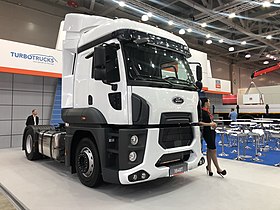This article needs attention from an expert in Trucks. The specific problem is: Missing technical information and information about North American version. (April 2016) |
| Ford Cargo | |
|---|---|
 | |
| Overview | |
| Manufacturer | Ford Motor Company |
| Also called |
|
| Production | 1981–present |
| Model years |
|
| Assembly |
|
| Designer | Patrick Le Quément (First Generation) |
| Body and chassis | |
| Class | Class 7 (USA) |
| Body style | Cabover |
| Powertrain | |
| Engine | 5.7 Dovertech I6 (1981-2003) 7.3 Ecotorq (2003-2015) 9.0 Ecotorq (2012-) 12.7 Ecotorq (2016-) |
| Dimensions | |
| Wheelbase | variable |
| Length | variable |
| Chronology | |
| Predecessor | Ford Transcontinental Ford C-Series (North America) Ford D-series (UK) Ford N-Series (Australasia) |
| Successor | Ford LCF (North America) Iveco Eurocargo (Great Britain) Ford F-Max |
The Ford Cargo is a forward-control (cab-over-engine) truck model manufactured by Ford since 1981. Designed by Ford of Britain as the successor of the Ford Transcontinental heavy commercial tractor, Ford introduced the Cargo to North America for 1986 as a medium-duty truck, intended to replace the long-running Ford C-Series.
Coinciding with the sale of Ford commercial truck production in Europe and North America, the Cargo design has been sold under multiple brands during its production life. In Europe, it was rebranded as an Iveco Ford, later becoming the Iveco Eurocargo. In North America, the Cargo was included in the 1997 sale of Ford heavy-truck lines to Freightliner, who marketed it as both a Freightliner and a Sterling through 2007.
Originally produced by Ford UK at its Langley facility from 1981 to 1993, the Cargo was also produced by Ford Brasil from 1981 to 2019 (the source of US-market production from 1986 to 1990); from 1991 to 1997, the line was produced by Ford by Kentucky Truck Assembly, in Louisville, Kentucky (for North America, replacing Ford Brasil). Current production of the line is sourced from Ford Otosan in Turkey.
- ^ a b "Auto Shanghai 2017: JMC's First Heavy Truck Weilong Shows up". Chinatrucks.com. April 21, 2017. Retrieved April 4, 2019.
- ^ Kent, Gordon (June 1986). "Intertruck: Britain". TRUCK. London, UK: FF Publishing Ltd: 39.